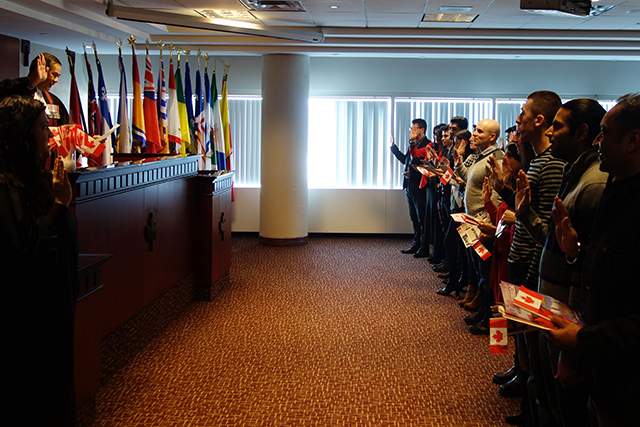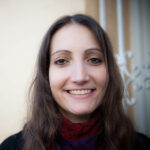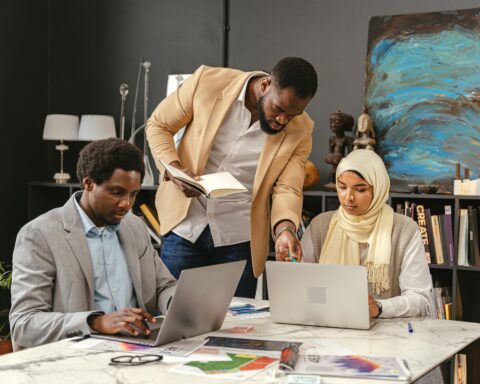Over 150 years after the Confederation of Canada, the first Indigenous Governor General has been inaugurated and the Canadian Oath of Citizenship revised to include the recognition of First Nations, Inuit and Métis rights.
These steps are part of the reconciliation process, with the new oath honouring the Truth and Reconciliation Commission’s Call to Action 94, and thereby laying “the foundation for a relationship built on respect and reciprocity,” says Charlene Seward, director of program development at Reconciliation Canada.
But how well do newcomers understand the oath? For new immigrants who haven’t been exposed to Indigenous history, “are these just words that they’re saying?” asks Lina Abouzaid, a newcomer from Egypt who felt extremely conflicted about this process.
According to Mariam Bilgrami, project manager of the Surrey Local Immigration Partnership (LIP), the study guide newcomers receive before taking their citizenship test is grossly outdated and misrepresentative of the real history of Canada.
In response to the TRC Call to Action 93, calling for revised information for newcomers to reflect a more inclusive history of diverse Indigenous peoples of Canada, Immigration, Refugees and Citizenship Canada (IRCC) has been working in collaboration with Inuit leadership through the Inuit Tapiriit Kanatami, the Métis National Council, and First Nations leaders to update the guide over the last few years. The revised guide is due to be released by the end of the year.
While these efforts are welcomed, Bilgrami says, it’s all “a drop in the ocean of the work that needs to happen.”
Newcomers Shocked to Learn the Truth
Most newcomers arrive in Canada with no knowledge of the country’s dark history, and there is a long gap between their arrival and their citizenship test.
“Canada is always marketed and displayed as this very welcoming place,” says Abouzaid, who, like many other immigrants, was shocked to learn the truth.
Abouzaid’s maternal grandmother is Palestinian. So, “the idea of stolen land and the dehumanization of people and the erasure of their history are things that I grew up around,” says Abouzaid. “When I found out about the history [of Canada], there was this moment where I was like, ‘I’m a hypocrite. I am living on stolen land, and how is that any different?’”
As her citizenship ceremony came closer, Abouzaid was torn between the knowledge of the sacrifices her family had made so she could have the opportunities that come with a Canadian passport and the thought of becoming part of Canada’s legacy of colonization.
Fostering Accessible Newcomer Education
Seward, from Reconciliation Canada, says those feelings are all part of what it means to “be a Canadian.”
“To be a Canadian is to accept and acknowledge Canada’s history, and it’s very much so a shared history,” she says. “It’s my history and it’s your history. And for anyone who lives on these lands, they also inherit that as their own.”
But language and financial barriers make it difficult for newcomers to access this critical learning.
Newcomers arrive in “a land that doesn’t belong to the people that are giving them the permission to come to this land,” says Bilgrami. “There’s no avenue for them to actually learn about the history in a true way, and then to even understand their roles as settlers on this land.”
Originally from Pakistan, Bilgrami first arrived in Canada for university. She learned nothing about Indigenous history until she married a man whose father came from the Nisga’a Nation, and he started learning more about his history, including that of residential schools.
Bilgrami sought out information online, but the true turning point in her understanding came years later, when she attended a workshop on decolonization with Ta7talíya Michelle Nahanee, a Sḵwx̱wú7mesh decolonial creative and strategist who uses social change to transform colonial narratives and impacts.
In June, the Surrey LIP released the First Peoples Guide for Newcomers, which aimed to answer the call for accurate resources on First Peoples in Canada from an Indigenous perspective. Rather than settlement staff making assumptions of what Indigenous people wanted newcomers to know and vice versa, they created a newcomer-Indigenous roundtable to get direct input from members of both communities.
Jeska Slater, a mixed-blood Nehiyah iskwew (Cree woman), who has been working in Indigenous communities for 10 years, spearheaded the process as a consultant.
The guide includes knowledge about traditional protocols, histories and current realities of Indigenous Peoples in Canada, addresses common misconceptions, and celebrates Indigenous brilliance.
Nahanee Creative, a team of Squamish creative professionals including Ta7talíya Michelle Nahanee, designed the guide.
Spaces for Reciprocal Relationship Building
Creating opportunities to build reciprocal relationships is key to building solidarity between newcomer and Indigenous communities.
“What we don’t speak to often enough is the shared experience,” says Seward. “So many newcomers to Canada also have this background — yes, of colonization, but of these rich histories, and we could learn so much from each other if we just took the time to develop and honour those relationships.”
As she studied towards her master’s in health administration at the University of British Columbia, Abouzaid learned about the low health outcomes of Indigenous people compared to the non-Indigenous population in Canada and began researching online to learn more. Through a subsequent Indigenous healthcare project, she built a relationship with Elder and Knowledge Keeper Roberta Price of the Snuneymuxw and Cowichan Nations, who has shared her knowledge and healing in education and healthcare settings for over 30 years.
In May 2019, Abouzaid shared her discomfort around the citizenship ceremony she had attended six weeks earlier and asked Price if there was a way to get permission to be on this land from Indigenous people.
Price invited her to attend an Elder Circle the next day. After introducing herself with her paternal and maternal lines to the six elders from the Squamish, Tsleil-Waututh and Musqueam Nations, Abouzaid went around the circle, offering tobacco that Price had prepared for each elder, and asked for their permission to be on this land.
Abouzaid remembers one of the elders hugging her and thanking her, saying they wished “when people first came to this land, they would have done something similar.”
Abouzaid says that’s when she finally felt she could live in Canada without feeling like a “complete intruder.”
Newcomers’ Role in Reconciliation
Learning Indigenous history also helps connect newcomers to the land on which they are now living, says Seward.
“If we don’t have that connection to the land, we don’t feel that same sense of responsibility towards it,” she says.
The term ‘Namwayut is a word in Kwak’wala, the language of the Kwakwaka’wakw peoples from northern Vancouver Island, smaller surrounding islands and adjacent mainland BC, and it translates as “we are all one,” Seward explains. According to her, it highlights the interconnectedness of everything, a fundamental principle in reconciliation.
Everyone in Canada has a role to play. For newcomers, like other Canadians, this will be “a journey of unlearning and relearning,” Seward says. “It requires humility and grace.”
Although the First People’s Guide for Newcomers is localized to the Surrey community, it is designed to be shareable and scalable. Bilgrami sought input from the Vancouver Immigration Partnership, which had already developed a guide for Vancouver, and hopes other municipalities will be inspired to create their own.
The guide will also be translated into 10 languages and made into an audio book, with follow up activities to help people engage meaningfully with the content. Having IRCC provide funding for such long-term, systemic work has been a welcome shift, says Bilgrami.
Abouzaid would like to see Indigenous people included in the planning and delivery of Canada’s citizenship ceremonies.
“I know I am an uninvited settler on this land still,” she says. “But at least I have the blessings of some Indigenous people. And I just wish that’s how it’s done for everyone.”
Daniela Cohen is a freelance journalist and writer of South African origin currently based in Vancouver, B.C. Her work has been published in the Canadian Immigrant, The/La Source Newspaper, the African blog, ZEKE magazine, eJewish Philanthropy, and Living Hyphen. Daniela's particular areas of interest are migration, justice, equity, diversity and inclusion. She is also the co-founder of Identity Pages, a youth writing mentorship program.





